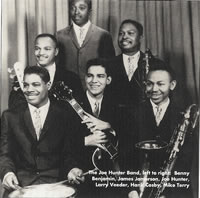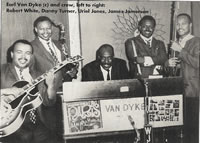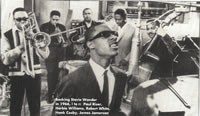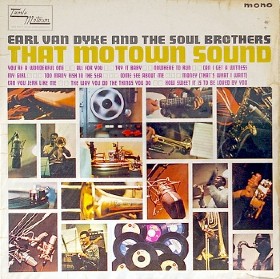According to the blurb for the highly entertaining documentary film, Standing In The Shadows Of Motown, “They played on more # 1 records than the Beatles, the Beach Boys, the Rolling Stones and Elvis Presley combined”. But unless you’ve seen the above film, chances are that you know very little about the Funk Brothers.
Among the vast array of singers, producers, songwriters, support personnel, and sales people that made up the Motown hit factory, the company’s secret ingredient for success was the wonderful studio band that played on almost all of Motown’s recordings during the golden years of the label when its headquarters was located in Detroit. Yet there is no entry for the Funk Brothers in The Rolling Stone Encyclopedia of Rock & Roll and there were just two paragraphs devoted to arguably the greatest of all studio bands in Rock Of Ages: The Rolling Stone History of Rock & Roll.
Although bassist James Jamerson and drummer Benny Benjamin have been inducted into the Rock and Roll Hall of Fame as sidemen, the rest of the musicians who made up the Funk Brothers had gone unrecognized up until Standing In The Shadows Of Motown was released in 2002.
When asked to define the Motown sound, Berry Gordy once jokingly referred to it as “a combination of rats, roaches, talent, guts and love”. Many would argue that the most essential ingredient was the label’s house band. The Funk Brothers were older than the Motown stars they recorded with and were veterans of Detroit’s vibrant jazz scene. But until recently, only those in the Motor City who were in the know understood that it was the same core group of musicians who played on all the hits recorded at Motown’s Studio A, or as James Jamerson referred to it, “the snake pit”.
It was not common practice during the 1960’s to list musician credits on recordings, and Gordy steadfastly kept the names of the individual Funk Brothers under wraps until 1971. Author Allan Slutsky, who wrote the book, Standing In The Shadows Of Motown, that inspired the documentary film, found that there were 79 different musicians who played on the Motown recordings, not counting those in the Detroit Symphony Orchestra. The National Association of Recording Arts and Science, however, identified just thirteen Funk Brothers for the Grammy Lifetime Achievement Award in 2004.
These same thirteen musicians: bassists James Jamerson and Bob Babbitt, drummers Benny Benjamin, Uriel Jones, and “Pistol” Allen, guitarists Joe Messina, Eddie Willis, and Robert White, keyboardists Earl Van Dyke, Johnny Griffith and Joe Hunter, and percussionists “Bongo” Brown and Jack Ashford were featured in the 2002 documentary, and were also recognized recently by a “star” on the Hollywood Walk of Fame. (Top) Joe Hunter (2nd row) James Jamerson, Hank Cosby (Bottom row) Benny Benjamin, Larry Veeder, Mike Terry
(Top) Joe Hunter (2nd row) James Jamerson, Hank Cosby (Bottom row) Benny Benjamin, Larry Veeder, Mike Terry
The earliest Funk Brothers, pianist Joe Hunter and drummer William “Benny” Benjamin were with Berry Gordy starting with his first Tamla recording session that produced Marv Johnson’s 1959 hit single, “Come to Me”. Hunter had just left Hank Ballard & The Midnighters in the fall of 1958 when Gordy invited him to join his studio band. Joe played on many other early Motown hits including “You’ve Really Got A Hold On Me”, “Heat Wave”, and “Pride And Joy” before he departed Motown in 1963.
Benny Benjamin hailed from Louisiana. Before relocating in Detroit, Benjamin’s first recording experience was backing blues shouter Wynonie Harris on his 1952 R&B hit, “Lovin’ Machine”. Nicknamed “Papa Zita”, Benjamin was the creator of the Motown drumbeat and one of the most beloved musicians at Motown. Benny’s signature style defined the Motown groove.
Joe Hunter credits Benny Benjamin with coining the band’s nickname. “Our drummer, Benny, really named us that. He used to call us the Funk Brothers,” he said. “We were the first two, and the rest of the group was formed behind us. Jamerson came a little later.”
Bassist James Jamerson moved to Detroit from South Carolina in 1954. He began playing the upright bass at Northwestern High School. In the late 1950’s he played locally with blues percussionist Washboard Willie and also backed singer J. J. Barnes. Jamerson’s first Motown session produced the Miracles’ “Way Over There”. Jamerson converted to the electric bass at Motown. He plucked the strings with only the index finger of his right hand which he dubbed “the hook”.
Robert White came to Motown after a stint as a guitarist for Harvey Fuqua’s new Moonglows which featured a young Marvin Gaye as one of the singers. White would constitute one-third of the Funk Brothers’ triple guitar approach. White would be called on by Motown producers whenever a distinct melody needed to be played on guitar, such as on the opening of “My Girl”.
Joe Messina, the white member of the Funk Brothers’ guitar triumvirate, joined in 1959. Messina’s specialty was the razor-sharp guitar backbeats heard on almost every Motown recording. Joe also worked in the house band for the popular Detroit television show starring comic Soupy Sales.
Eddie Willis started his career as the guitarist for Marv Johnson while he was still in his teens. Eddie’s role in the band was to play the funky fills and rhythms off the foundation laid down by White and Messina.
In the latter part of the 1960’s Dennis Coffey would play an important role on many Motown recordings. His famous guitar intro to the Temptations’ classic “Cloud Nine” introduced the wah-wah pedal into the Motwn recording studio and ushered in the era of ‘psychedelic soul’ at the label.
 (L to R) Robert White, Danny Turner, Earl Van Dyke, Uriel Jones, James Jamerson
(L to R) Robert White, Danny Turner, Earl Van Dyke, Uriel Jones, James Jamerson
Melvin “Wah Wah” Watson first played in Studio A on the 1970 session for Edwin Starr’s “Stop The War Now”. He would be one of the few Detroit musicians to make a full transition to Los Angeles after Motown moved its operation there.
Keyboard player Earl Van Dyke joined the Funk Brothers in 1962 after being on the road with both Lloyd Price and Aretha Franklin. Van Dyke was born in Detroit and had been playing piano since he was fourteen. Like most of the other Funk Brothers, Earl considered jazz his first love. He was viewed as the unofficial bandleader, not only for his musical talent but also because he always knew where to find the Funk Brothers and get them into the studio. This was no small feat when trying to control James Jamerson, Benny Benjamin, and some of the other more “colorful personalities in the band.
Johnny Griffith was one of the few classically trained musicians in the Funk Brothers. Johnny was lured into Motown in 1961 to play jazz, but he became very valuable in the studio as a second keyboard to Earl Van Dyke. Griffith and VanDyke spent the next ten years trading off acoustic piano, Hammond organ, and Wurlitzer electric piano in Studio A. James Gittens also played keyboards in the band until his death in 1965 in an auto accident.
Percussionist Jack Ashford’s vibes and tambourine accents were also an important part of Motown’s dance beat. Ashford was a Philadelphia native who came to Motown because of Marvin Gaye. Gaye was him playing in a jazz combo in Boston in 1962 and offered him a job in his band. At the time, Ashford only played jazz and he hadn’t ever heard of Gaye. That led to Ashford coming to Detroit and becoming an important member of the Funk Brothers. Dave Hamilton and Jack Brokensha were also important percussionists who played at Motown.
Richard “Pistol” Allen was a jazz drummer who was recruited into Motown by his mentor Benny Benjamin. Pistol provided Motown with a new drum style that featured a sledgehammer backbeat with a heavy hi-hat that offered producers a nice variation to what Benny and Uriel Jones were doing. Pistol’s style was a favorite of Holland-Dozier-Holland, and he played on most of their recordings.
Uriel Jones toured with Marvin Gaye and various Motown road shows before he became a Hitsville drummer in 1964. He was considered the funkiest of Motown’s three drummers. Uriel was an integral part of Norman Whitfield’s “psychedelic soul” recordings and was the main drummer when the Funk Brothers performed at the Chit Chat Club, the Twenty Grand, and other Detroit nightlife venues.
Eddie “Bongo” Brown was the comedian in the Funk Brothers who kept things loose in Studio A. He first came to Motown as Marvin Gaye’s valet, but soon became Motown’s most prolific conga player gracing many of the label’s greatest recordings with his Latin and jazz grooves.
Bob Babbitt played bass in the Royaltones and in Stevie Wonder’s touring band before joining the Funk Brothers in 1967. He became especially valuable in light of James Jamerson’s alcohol-related health problems. He played at Hitsville for six years and was a particular favorite of producer Norman Whitfield.
Dennis Coffey joined the Funk Brothers in the late 1960's and played on dozens of recordings at Hitsville. Coffey introduced a hard rock guitar sound to Motown producer Norman Whitfield's recordings, including distortion, Echoples tape-loop delay, and wah-wah - most notably on the psychedelic soul hits of the Temptations.
 Stevie Wonder and The Funk Brothers
Stevie Wonder and The Funk Brothers
As important as the mighty rhythm section was to Motown recordings, the horn players with the Funk Brothers cannot be discounted. Hank Crosby was the most frequently used tenor sax soloist during the early days. Ron Wakefield also played on some early recordings, most notably “Shop Around”. Norris Paterson came in as another primary tenor sax soloist during the latter part of the 1960’s
Baritone sax player and Detroit native Andrew “Mike” Terry played a number of impressive solos during the 1960’s on hits by the Supremes and the Four Tops. The baritone sax had seldom been used as an R&B solo instrument before Terry’s work at Motown.
Thomas “Beans” Bowles was the flute specialist in the early years and doubled on baritone sax. Teddy Buckner, Wild Bill Moore, Dan Turner, Lefty Edwards, and Eli Fontaine were all important members of the reed section at Motown.
Marcus Belgrave was a standout at trumpet along with Johnny Trudell, Herbie Williams, John Wilson, and Russell Conway. The trombone was covered by George Bohanon, Bob Cousar, Jimmy Wilkins, Patrick Lanier, and Paul Riser.
 Funk Brothers recording session
Funk Brothers recording session
Berry Gordy demanded assembly line efficiency inside Motown’s famous Studio A. Jack Ashford remembered in Bill Dahl’s excellent book, Motown: The Golden Years; “Sessions started at 10:00 a.m., and we were over in the afternoon. They were three-hour sessions most of the time. But they could call a session seven days a week. We were on call. A lot of times we cut at night, which we didn’t mind. It was a gig. ‘Cause we were only getting, most of the time, $10 a song. It was the only game in town”.
Ashford remembered that the Funk Brothers would play in jazz clubs like Millies’ Chit Chat Lounge or Phelps’ Lounge. Many of the rhythmic patterns that appeared on the Motown hits were the result of late night jams at the jazz clubs in Detroit. As Motown gradually came to dominate the radio airwaves, the salaries of the Funk Brothers grew accordingly. Their name recognition, however, did not.
Fraternization between the Funk Brothers and the youthful singers at Motown was discouraged. Jack Ashford claims, “We didn’t see the singers much when we did our sessions. They were instructed to stay away from us. So they rarely did associate with us. Since the backing tracks were usually laid down prior to the singers’ arrival at Studio A from the middle 1960’s on, interaction was effectively minimized.
Motown was less successful at preventing their musicians from moonlighting at other labels, however. The Funk Brothers cut most of the records released on Ed Wingate’s Golden World and Ric-Tic labels and also many of the sides released on Holland-Dozier-Holland’s Hot Wax and Invictas labels. It was also the Funk Brothers playing on “Cool Jerk” by the Capitols, “Boom Boom” by John Lee Hooker, and “(Your Love Keeps Lifting Me) Higher And Higher” by Jackie Wilson.
Whenever Gordy got word that his musicians were working for another label, he would dispatch someone from management to investigate, sometimes bursting into a recording session in the middle of the night to take down the names of those who worked at Motown. This resulted in a system of fines and suspensions for the Funk Brothers who were caught. Although it never completely stopped the moonlighting, the incidents sometimes caused very bad feelings between former friends and musical cohorts. 
The Funk Brothers released a few scattered singles on Motown’s Soul label under Earl Van Dyke’s name. The first single, “Soul Stomp/Hot ‘N’ Tot” came out in 1964. In 1965, an instrumental album was released called “That Motown Sound”. It was released on the Motown label and credited to Earl Van Dyke and the Soul Brothers. Gordy did not like the name Funk Brothers and did not want to put it on the album. Motown used the Soul Brothers name for two more singles; instrumental versions of “I Can’t Help Myself/How Sweet It Is” and “The Flick Pt. 1/ The Flick Pt. 2”, both released in 1965.
Van Dyke released a final single in 1966, “6 By 6/There Is No Greater Love”, credited to Earl Van Dyke & the Motown Brass. A second album, called “The Earl Of Funk”, was released in 1970.
When Motown shifted its operation to Los Angeles in the early 1970’s, only Van Dyke, Jamerson, Brown, and Ashford migrated west. The others stayed put in Detroit. This, more than anything, marked the end of the label's golden era.
Sadly, the years have taken their toll on the Funk Brothers. Jamerson, Benjamin, Van Dyke, and White all passed away before the documentary film, Standing In The Shadows Of Motown was completed. According to Ashford, they died brokenhearted. “They felt as though their lives were unfulfilled.” Hunter, Jones, Allen, and Griffith have died since the film was released, but at least they had a chance to enjoy some of the recognition that was long overdue. Other Funk Brothers who have passed away in recent years include Eddie
Willis, Joe Messina, and Bob Babbitt.
In the final paragraph of Bill Dahl’s chapter on the Funk Brothers, Jack Ashford sums it up best; “If God blessed Berry Gordy for making it happen, then the angels kissed the Funk Brothers for furthering his dream. Because without the Funk Brothers, there would have been no Motown.”
In 2010, the Funk Brothers were voted into Michigan Rock and Roll Legends Hall of Fame.
Dr. J. Recommends:
Standing In the Shadows Of Motown DVD Artsan Home Entertainment 2003.  A must-see for any fan of Motown or Michigan Rock and Roll. This highly entertaining film tells the story of the Funk Brothers and serves to finally give them the credit they richly deserve as the driving force behind Berry Gordy's hit-making machine.
A must-see for any fan of Motown or Michigan Rock and Roll. This highly entertaining film tells the story of the Funk Brothers and serves to finally give them the credit they richly deserve as the driving force behind Berry Gordy's hit-making machine.
“Hitsville USA: The Motown Singles Collection 1959 – 1971”. Motown Record Co. 1992. This fabulous 4 CD set contains 104 classic songs recorded during Motown’s golden years in Detroit. Most of the recordings in this collection were done at Studio A and feature the Funk Brothers.
“The Best Of the Funk Brothers” Motown Chronicles – Universal Music Company 2004. I have some reservations about this CD. First of all, there are only 12 songs. Secondly, the collection does not include all of the Funk Brothers (Soul Brothers) singles. Although it does give you a chance to hear these little-heard recordings, the best work of the Funk Brothers remains on the countless recordings that they made with the other Motown artists in Studio A.

